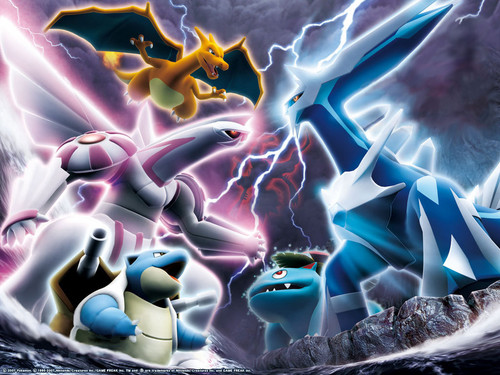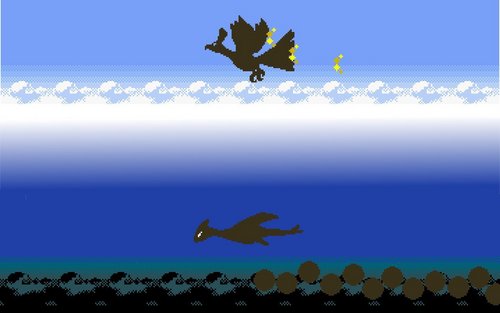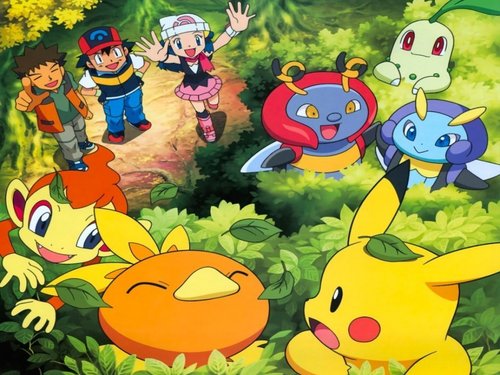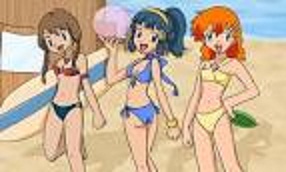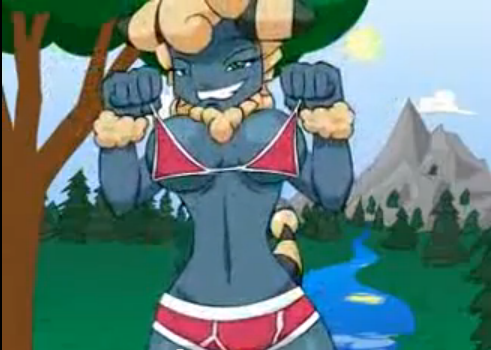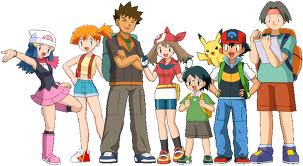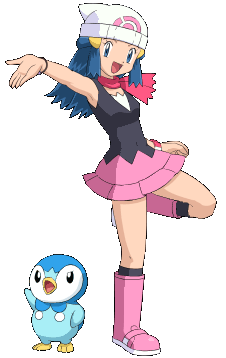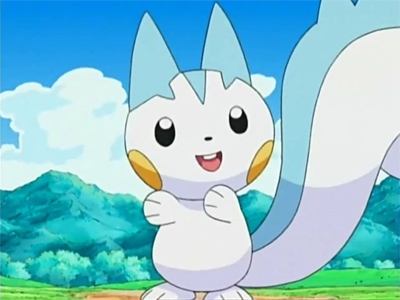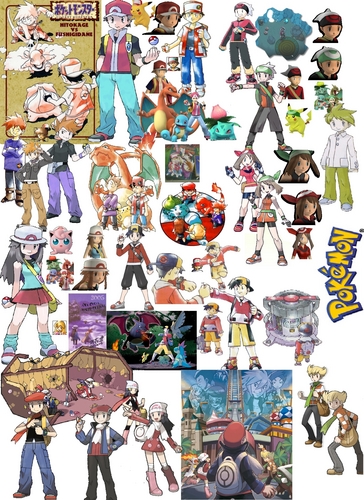Here are the trivias for the specific 포켓몬스터 generation. Enjoy.
Generation I Trivia
Of all the generations, Generation I introduced the most moves to the series, with 165.
Excluding Generation III's FireRed and LeafGreen (as they are remakes), Generation I is the only generation so far whose mascots are non-legendary Pokémon.
As far as release dates go, Generation I is the shortest generation in North America, partly due to the fact that Red and Blue were not released until 1998, while in Japan, they were released in 1996, and their successors, Gold and Silver, were released closer together, in 1999 in 일본 and 2000 in North America. As the rest of the world's releases are 더 많이 similar to the North American releases than the Japanese releases, it is also the shortest generation worldwide.
Due to being the first and least advanced generation, Generation I has the highest number of glitch 포켓몬스터 which are known to be obtainable without the use of an external device.
Prior to Generation VI, Generation I had the most extra 우주 in the 포켓몬스터 Storage System if the player captures one of each Pokémon, with 240 spots available for 151 Pokémon, leaving 89 extra spots.
Generation I is the only generation not to feature the paired versions' mascots on the 제목 screens, but instead includes the first evolutionary stages of two starter Pokémon.
Generation I is the only generation without a playable female character, although evidence of an intended female player character has been discovered.
Generation I is the only generation that indexes its 포켓몬스터 in order of creation instead of 의해 Pokédex number.
Generation I is the only generation where a playable protagonist and a rival introduced in that generation does not appear in this generation's remakes in a later generation.
Generation I is the only generation where a playable protagonist introduced in that generation only uses any of the original 151 포켓몬스터 when that protagonist is playable and not uses any other 포켓몬스터 from Generation II onwards. Even during the time this playable protagonist appear in a 포켓몬스터 generation after Generation I as an NPC.
Generation II Trivia
Generation II is the smallest generation so far with only seven games and three core series games.
Generation II is the only generation in which:
The starters are initially holding an item.
The starters remain single-type 포켓몬스터 throughout their evolutions. They are also the only trio whose evolutions do not share any weaknesses with each other.
The total number of moves are equal to the total number of 포켓몬스터 at the time.
Each 포켓몬스터 has a different sprite in the original pair of games (except for Unown and the Johto Legendary trio).
Generation II is also the only generation that did not introduce:
New Fossil 포켓몬스터 nor any Fossils to be found 또는 revived (though an Aerodactyl can be obtained through an in-game trade).
A Dragon-type pseudo-legendary Pokémon.
A two-stage, cat-like evolutionary line.
A new villainous team.
A new Victory Road.
In terms of release dates, Generation II is the shortest generation in Japan, with exactly three years between the release of Gold and Silver and Ruby and Sapphire.
Generation II leaves the least extra 우주 for 포켓몬스터 in the Storage System if one of every species is caught. Only 280 포켓몬스터 may be obtained at once; there are 251 different 포켓몬스터 species available in this generation.
Generation II features the first main series game, Crystal, whose Japanese 제목 is in katakana only and that uses an English word, rather than using the Japanese counterpart word in kanji. No game since has been named in kanji.
Unlike in other generations, should the player use a glitch 또는 cheat in a Generation II game to get into tall 잔디 without a Pokémon, the fight will instantly end (and be treated as a victory in case of Trainers), instead of the player sending out a glitch Pokémon.
Generation III Trivia
Generation III introduced the most Abilities to the series, with 77 (including Cacophony).
Generation III was the first generation to:
Include both a mother and father for the main character and the rival.
Introduce multiple Legendary trios (the weather trio and the Legendary titans).
Introduce multiple Mythical Pokémon.
Not introduce any new evolutions for Eevee.
Not allow the customization of a rival character's name.
Have multiple paired versions, one pair of which are remakes.
Give the Elite Four its own battle music, as opposed to them sharing the same battle 음악 as the Gym Leaders in 이전 generations. However, FireRed, LeafGreen, HeartGold, SoulSilver, Diamond, Pearl and Platinum still do this, with the latter three's Elite Four battle 음악 having a lower pitch 의해 one semitone.
Use wireless connectivity.
Feature the word "Pokémon" in the logos of the Japanese titles, alongside "Pocket Monsters."
Introduce two sets of player characters.
Generation III is the only generation that:
Introduced two pseudo-legendary Pokémon.
Is unable to communicate with games from the 이전 generation.
A playable protagonist and a rival introduced in the original games in the 이전 generation do not appear in the original games' remakes.
One set of player characters and a rival were introduced in the remakes instead of the original player character and the original rival from the original games reprise the role in the remakes.
Generation III does not introduce any evolved forms of 포켓몬스터 from 이전 generations (a trait shared with Generation V), with the only cross-generational relatives being baby 포켓몬스터 Azurill and Wynaut.
Generation III introduced the most 포켓몬스터 that are unable to evolve, with a total of 21 at the time.
Generation III has the largest number of total games, with fifteen. It is tied with Generation IV for the largest number of core series games, with five each.
Starting with Generation III, Ken Sugimori's art style shows noticeable differences from that of Generation I and II. This can be seen when comparing the artwork for Generation I and II 포켓몬스터 from their original games to that of those games' remakes. This can also be seen when comparing the artwork for Red and Ethan to that of 포켓몬스터 Sun and Moon in Generation VII and 포켓몬스터 HeartGold and SoulSilver in Generation IV respectively.
Most of the Generation III 포켓몬스터 that are not in the Sinnoh Pokédex have only one sprite in the Generation IV games. Generation IV 포켓몬스터 received sprite 업데이트 in 포켓몬스터 Platinum, while Generation I and II 포켓몬스터 received 업데이트 in 포켓몬스터 HeartGold and SoulSilver.
Almost all the backsprites of non-Generation III 포켓몬스터 are revamps of the backsprites in the Generation II games.
Generation III is the longest generation in North America, lasting slightly over four years.
Generation III is the only generation which was longer in the West than in Japan.
Generation III is the only generation to not contain games that takes place in the Kanto region in which Red and Blue appear.
Generation III is the first generation to not contain games in which Red and Blue appear.
Generation IV Trivia
Every player character in all Generation IV games has a Wii in his/her room, referencing its status as the current 닌텐도 console during the generation. Previously, in Generation I, Red had a Super Nintendo. In Generation III, Brendan and May had 닌텐도 GameCubes in their rooms, and 불, 화재 and Leaf had an NES. In Generation VI, Calem, Serena, Brendan, and May have a Wii U in their rooms.
Generation IV is the only generation in which:
Two core series game names have the same first initial in English (Pearl and Platinum); other languages, however, have had the same initial in their game names, with Spanish Azul and Amarillo for Blue and Yellow, and German Saphir and Smaragd for Sapphire and Emerald.
All its games were released in the spring in North America, and in the fall in Japan.
The final evolution of each starter 포켓몬스터 is owned 의해 one Gym Leader 또는 Elite Four member.
Crasher Wake has an Empoleon, Gardenia has a Torterra, and Flint has an Infernape.
Generation IV is also the only generation that did not introduce:
A Rock/Water-type Pokémon.
A Gym Leader 또는 Elite Four member specializing in Dragon-type Pokémon.
A Flying-type Legendary Pokémon.
Generation IV is the first generation to include:
Level 1 포켓몬스터 legitimately obtainable in the core series.
Compatibility with both the generation preceding and following it.
Generation IV is the longest 포켓몬스터 generation in Japan, falling only 10 days short of being four years long.
Generation IV is tied with Generation III for the largest number of core series games, with five each.
Generation IV introduced the largest number of evolutions for 포켓몬스터 of 이전 generations, at 29.
Generation IV introduced the largest number of legendary Pokémon, with 13.
Generation IV features the largest number of playable core series regions, with three.
Generation IV is the first generation officially released in South Korea 의해 Nintendo's local subsidiary there. Even though the Generation II games 포켓몬스터 Gold and Silver were released in South Korea on April 24, 2002, they were a result of 닌텐도 partnering with Daewon as 닌텐도 of Korea would not be established until July 7, 2006.
At 716 days, the time between 포켓몬스터 Diamond and Pearl Versions and 포켓몬스터 Platinum Version is the longest gap in-between two main series games in the same generation.
Generation V Trivia
The Japanese logo of the 포켓몬스터 games was redesigned once again for Generation V's releases; the first logo was used in Generation I and Generation II, and the 초 during Generation III and Generation IV.
The text for the English boxes also received a new design.
Generation V introduced the most new 포켓몬스터 to the series, with 156 (five 더 많이 than Generation I introduced).
Generation V introduced the most Gym Leaders, with 14.
In addition, not counting remakes, this is the first generation to introduce 더 많이 than eight Gym Badges (ten, due to Black 2 and White 2 replacing two of them).
Generation V is the first generation not to feature Professor Oak.
Generation V is the first generation not to introduce a higher number of Legendary 포켓몬스터 than the 이전 generation. In this case, both Generations IV and V introduced nine Legendary Pokémon.
Generation V is the only generation in which:
There is only one fishing rod—the Super Rod—as the Old Rod and Good Rod have been removed.
The primary paired versions were released in 유럽 before North America.
A single-type 포켓몬스터 of every type is introduced.
A pure Flying-type is introduced.
The main professor is female.
피카츄 is not available without transferring from the 이전 generation.
A Snorlax is not sleeping in the overworld.
Generation V is also the only generation that did not introduce:
A Bug/Flying Pokémon.
A cross-generational evolutionary relative.
Generation V is the first generation not to introduce a solitary core series game, instead introducing sequels.
Generation V is the first generation in which it is impossible to complete the National Pokédex without transferring 포켓몬스터 from a 이전 generation, even if a player owned all versions in the generation and all Event 포켓몬스터 were acquired.
Generation V is the first generation since Generation II not to include remakes of 이전 games.
Generation V is the first generation that does not feature the Kanto region.
Generation V is the first generation that allowed trading with Korean versions.
포켓몬스터 caught in a Korean Generation IV game are still technically compatible with other Generation IV games, but those games did not have a way to read the Korean characters in the Pokémon's name. All Generation V games, however, included Korean character compatibility, thus allowing Korean 포켓몬스터 to be traded between all other versions of the game.
Generation V is the first generation since Generation III in which two sets of player characters were introduced.
Generation VI Trivia
Generation VI introduced the fewest new Pokémon, with 72; new moves, with 62; and new Abilities, with 27.
This makes it the only generation to introduce fewer than 100 new Pokémon.
Generation VI is the only generation in which:
Gym Leaders in games that are not remakes hand out TMs containing moves from older generations.
Games were released on the same 날짜 worldwide.
It is possible to import 포켓몬스터 from 이전 generations, but is not required in order to complete the National Pokédex (excluding Mythical Pokémon).
Generation VI is also the only generation that did not introduce:
A Water/Flying Pokémon.
A Bug/Poison Pokémon.
A pure Ground-type Pokémon.
A pure Electric-type Pokémon.
A Mythical 포켓몬스터 with a base stat total of 600 and a stat distribution of 100 all around.
A Legendary 포켓몬스터 with a base stat total of 580.
A pseudo-legendary 포켓몬스터 with two types.
A Gym Leader 또는 Elite Four member specializing in Ghost-type Pokémon.
A new type of Poké Ball.
A department store.
A numbered water route.
Generation VI introduced the fewest Legendary 포켓몬스터 of any generation, introducing three.
Generation VI relieved restrictions on formatting that were evident in 이전 generations:
The nickname character has been increased from 5 to 6 in Japanese and Korean, and from 10 to 12 in Western languages.
The player name character has been increased from 5 to 6 in Japanese and Korean, and from 7 to 12 in Western languages.
The names of all moves, items and Abilities introduced before Generation VI are no longer limited to 12 characters, including any spaces. Some of these names were re-formatted; for example, Selfdestruct was renamed Self-Destruct.
Generation VI leaves the most extra room in the PC if one captures exactly one of each species of Pokémon, with there being 930 spaces and 721 Pokémon.
Generation VI is the only generation not to revisit its new region after the original paired games.
Generation VI contains the core series games with both the shortest and longest English titles: X and Y have one letter each, whereas Alpha Sapphire has fourteen characters including the 우주 (excluding the word "Pokémon").
Generation VI is the first generation to not contain games in which Brock, Misty, Lt. Surge, Erika, Koga, Sabrina, Blaine, and Lance appear.
Generation VI is the first generation since Generation III to not contain games in which Red and Blue appear.
OK, that's it. There's 더 많이 future trivia 코멘트 the 다음 time I put in 더 많이 trivia comments.
Generation I Trivia
Of all the generations, Generation I introduced the most moves to the series, with 165.
Excluding Generation III's FireRed and LeafGreen (as they are remakes), Generation I is the only generation so far whose mascots are non-legendary Pokémon.
As far as release dates go, Generation I is the shortest generation in North America, partly due to the fact that Red and Blue were not released until 1998, while in Japan, they were released in 1996, and their successors, Gold and Silver, were released closer together, in 1999 in 일본 and 2000 in North America. As the rest of the world's releases are 더 많이 similar to the North American releases than the Japanese releases, it is also the shortest generation worldwide.
Due to being the first and least advanced generation, Generation I has the highest number of glitch 포켓몬스터 which are known to be obtainable without the use of an external device.
Prior to Generation VI, Generation I had the most extra 우주 in the 포켓몬스터 Storage System if the player captures one of each Pokémon, with 240 spots available for 151 Pokémon, leaving 89 extra spots.
Generation I is the only generation not to feature the paired versions' mascots on the 제목 screens, but instead includes the first evolutionary stages of two starter Pokémon.
Generation I is the only generation without a playable female character, although evidence of an intended female player character has been discovered.
Generation I is the only generation that indexes its 포켓몬스터 in order of creation instead of 의해 Pokédex number.
Generation I is the only generation where a playable protagonist and a rival introduced in that generation does not appear in this generation's remakes in a later generation.
Generation I is the only generation where a playable protagonist introduced in that generation only uses any of the original 151 포켓몬스터 when that protagonist is playable and not uses any other 포켓몬스터 from Generation II onwards. Even during the time this playable protagonist appear in a 포켓몬스터 generation after Generation I as an NPC.
Generation II Trivia
Generation II is the smallest generation so far with only seven games and three core series games.
Generation II is the only generation in which:
The starters are initially holding an item.
The starters remain single-type 포켓몬스터 throughout their evolutions. They are also the only trio whose evolutions do not share any weaknesses with each other.
The total number of moves are equal to the total number of 포켓몬스터 at the time.
Each 포켓몬스터 has a different sprite in the original pair of games (except for Unown and the Johto Legendary trio).
Generation II is also the only generation that did not introduce:
New Fossil 포켓몬스터 nor any Fossils to be found 또는 revived (though an Aerodactyl can be obtained through an in-game trade).
A Dragon-type pseudo-legendary Pokémon.
A two-stage, cat-like evolutionary line.
A new villainous team.
A new Victory Road.
In terms of release dates, Generation II is the shortest generation in Japan, with exactly three years between the release of Gold and Silver and Ruby and Sapphire.
Generation II leaves the least extra 우주 for 포켓몬스터 in the Storage System if one of every species is caught. Only 280 포켓몬스터 may be obtained at once; there are 251 different 포켓몬스터 species available in this generation.
Generation II features the first main series game, Crystal, whose Japanese 제목 is in katakana only and that uses an English word, rather than using the Japanese counterpart word in kanji. No game since has been named in kanji.
Unlike in other generations, should the player use a glitch 또는 cheat in a Generation II game to get into tall 잔디 without a Pokémon, the fight will instantly end (and be treated as a victory in case of Trainers), instead of the player sending out a glitch Pokémon.
Generation III Trivia
Generation III introduced the most Abilities to the series, with 77 (including Cacophony).
Generation III was the first generation to:
Include both a mother and father for the main character and the rival.
Introduce multiple Legendary trios (the weather trio and the Legendary titans).
Introduce multiple Mythical Pokémon.
Not introduce any new evolutions for Eevee.
Not allow the customization of a rival character's name.
Have multiple paired versions, one pair of which are remakes.
Give the Elite Four its own battle music, as opposed to them sharing the same battle 음악 as the Gym Leaders in 이전 generations. However, FireRed, LeafGreen, HeartGold, SoulSilver, Diamond, Pearl and Platinum still do this, with the latter three's Elite Four battle 음악 having a lower pitch 의해 one semitone.
Use wireless connectivity.
Feature the word "Pokémon" in the logos of the Japanese titles, alongside "Pocket Monsters."
Introduce two sets of player characters.
Generation III is the only generation that:
Introduced two pseudo-legendary Pokémon.
Is unable to communicate with games from the 이전 generation.
A playable protagonist and a rival introduced in the original games in the 이전 generation do not appear in the original games' remakes.
One set of player characters and a rival were introduced in the remakes instead of the original player character and the original rival from the original games reprise the role in the remakes.
Generation III does not introduce any evolved forms of 포켓몬스터 from 이전 generations (a trait shared with Generation V), with the only cross-generational relatives being baby 포켓몬스터 Azurill and Wynaut.
Generation III introduced the most 포켓몬스터 that are unable to evolve, with a total of 21 at the time.
Generation III has the largest number of total games, with fifteen. It is tied with Generation IV for the largest number of core series games, with five each.
Starting with Generation III, Ken Sugimori's art style shows noticeable differences from that of Generation I and II. This can be seen when comparing the artwork for Generation I and II 포켓몬스터 from their original games to that of those games' remakes. This can also be seen when comparing the artwork for Red and Ethan to that of 포켓몬스터 Sun and Moon in Generation VII and 포켓몬스터 HeartGold and SoulSilver in Generation IV respectively.
Most of the Generation III 포켓몬스터 that are not in the Sinnoh Pokédex have only one sprite in the Generation IV games. Generation IV 포켓몬스터 received sprite 업데이트 in 포켓몬스터 Platinum, while Generation I and II 포켓몬스터 received 업데이트 in 포켓몬스터 HeartGold and SoulSilver.
Almost all the backsprites of non-Generation III 포켓몬스터 are revamps of the backsprites in the Generation II games.
Generation III is the longest generation in North America, lasting slightly over four years.
Generation III is the only generation which was longer in the West than in Japan.
Generation III is the only generation to not contain games that takes place in the Kanto region in which Red and Blue appear.
Generation III is the first generation to not contain games in which Red and Blue appear.
Generation IV Trivia
Every player character in all Generation IV games has a Wii in his/her room, referencing its status as the current 닌텐도 console during the generation. Previously, in Generation I, Red had a Super Nintendo. In Generation III, Brendan and May had 닌텐도 GameCubes in their rooms, and 불, 화재 and Leaf had an NES. In Generation VI, Calem, Serena, Brendan, and May have a Wii U in their rooms.
Generation IV is the only generation in which:
Two core series game names have the same first initial in English (Pearl and Platinum); other languages, however, have had the same initial in their game names, with Spanish Azul and Amarillo for Blue and Yellow, and German Saphir and Smaragd for Sapphire and Emerald.
All its games were released in the spring in North America, and in the fall in Japan.
The final evolution of each starter 포켓몬스터 is owned 의해 one Gym Leader 또는 Elite Four member.
Crasher Wake has an Empoleon, Gardenia has a Torterra, and Flint has an Infernape.
Generation IV is also the only generation that did not introduce:
A Rock/Water-type Pokémon.
A Gym Leader 또는 Elite Four member specializing in Dragon-type Pokémon.
A Flying-type Legendary Pokémon.
Generation IV is the first generation to include:
Level 1 포켓몬스터 legitimately obtainable in the core series.
Compatibility with both the generation preceding and following it.
Generation IV is the longest 포켓몬스터 generation in Japan, falling only 10 days short of being four years long.
Generation IV is tied with Generation III for the largest number of core series games, with five each.
Generation IV introduced the largest number of evolutions for 포켓몬스터 of 이전 generations, at 29.
Generation IV introduced the largest number of legendary Pokémon, with 13.
Generation IV features the largest number of playable core series regions, with three.
Generation IV is the first generation officially released in South Korea 의해 Nintendo's local subsidiary there. Even though the Generation II games 포켓몬스터 Gold and Silver were released in South Korea on April 24, 2002, they were a result of 닌텐도 partnering with Daewon as 닌텐도 of Korea would not be established until July 7, 2006.
At 716 days, the time between 포켓몬스터 Diamond and Pearl Versions and 포켓몬스터 Platinum Version is the longest gap in-between two main series games in the same generation.
Generation V Trivia
The Japanese logo of the 포켓몬스터 games was redesigned once again for Generation V's releases; the first logo was used in Generation I and Generation II, and the 초 during Generation III and Generation IV.
The text for the English boxes also received a new design.
Generation V introduced the most new 포켓몬스터 to the series, with 156 (five 더 많이 than Generation I introduced).
Generation V introduced the most Gym Leaders, with 14.
In addition, not counting remakes, this is the first generation to introduce 더 많이 than eight Gym Badges (ten, due to Black 2 and White 2 replacing two of them).
Generation V is the first generation not to feature Professor Oak.
Generation V is the first generation not to introduce a higher number of Legendary 포켓몬스터 than the 이전 generation. In this case, both Generations IV and V introduced nine Legendary Pokémon.
Generation V is the only generation in which:
There is only one fishing rod—the Super Rod—as the Old Rod and Good Rod have been removed.
The primary paired versions were released in 유럽 before North America.
A single-type 포켓몬스터 of every type is introduced.
A pure Flying-type is introduced.
The main professor is female.
피카츄 is not available without transferring from the 이전 generation.
A Snorlax is not sleeping in the overworld.
Generation V is also the only generation that did not introduce:
A Bug/Flying Pokémon.
A cross-generational evolutionary relative.
Generation V is the first generation not to introduce a solitary core series game, instead introducing sequels.
Generation V is the first generation in which it is impossible to complete the National Pokédex without transferring 포켓몬스터 from a 이전 generation, even if a player owned all versions in the generation and all Event 포켓몬스터 were acquired.
Generation V is the first generation since Generation II not to include remakes of 이전 games.
Generation V is the first generation that does not feature the Kanto region.
Generation V is the first generation that allowed trading with Korean versions.
포켓몬스터 caught in a Korean Generation IV game are still technically compatible with other Generation IV games, but those games did not have a way to read the Korean characters in the Pokémon's name. All Generation V games, however, included Korean character compatibility, thus allowing Korean 포켓몬스터 to be traded between all other versions of the game.
Generation V is the first generation since Generation III in which two sets of player characters were introduced.
Generation VI Trivia
Generation VI introduced the fewest new Pokémon, with 72; new moves, with 62; and new Abilities, with 27.
This makes it the only generation to introduce fewer than 100 new Pokémon.
Generation VI is the only generation in which:
Gym Leaders in games that are not remakes hand out TMs containing moves from older generations.
Games were released on the same 날짜 worldwide.
It is possible to import 포켓몬스터 from 이전 generations, but is not required in order to complete the National Pokédex (excluding Mythical Pokémon).
Generation VI is also the only generation that did not introduce:
A Water/Flying Pokémon.
A Bug/Poison Pokémon.
A pure Ground-type Pokémon.
A pure Electric-type Pokémon.
A Mythical 포켓몬스터 with a base stat total of 600 and a stat distribution of 100 all around.
A Legendary 포켓몬스터 with a base stat total of 580.
A pseudo-legendary 포켓몬스터 with two types.
A Gym Leader 또는 Elite Four member specializing in Ghost-type Pokémon.
A new type of Poké Ball.
A department store.
A numbered water route.
Generation VI introduced the fewest Legendary 포켓몬스터 of any generation, introducing three.
Generation VI relieved restrictions on formatting that were evident in 이전 generations:
The nickname character has been increased from 5 to 6 in Japanese and Korean, and from 10 to 12 in Western languages.
The player name character has been increased from 5 to 6 in Japanese and Korean, and from 7 to 12 in Western languages.
The names of all moves, items and Abilities introduced before Generation VI are no longer limited to 12 characters, including any spaces. Some of these names were re-formatted; for example, Selfdestruct was renamed Self-Destruct.
Generation VI leaves the most extra room in the PC if one captures exactly one of each species of Pokémon, with there being 930 spaces and 721 Pokémon.
Generation VI is the only generation not to revisit its new region after the original paired games.
Generation VI contains the core series games with both the shortest and longest English titles: X and Y have one letter each, whereas Alpha Sapphire has fourteen characters including the 우주 (excluding the word "Pokémon").
Generation VI is the first generation to not contain games in which Brock, Misty, Lt. Surge, Erika, Koga, Sabrina, Blaine, and Lance appear.
Generation VI is the first generation since Generation III to not contain games in which Red and Blue appear.
OK, that's it. There's 더 많이 future trivia 코멘트 the 다음 time I put in 더 많이 trivia comments.










